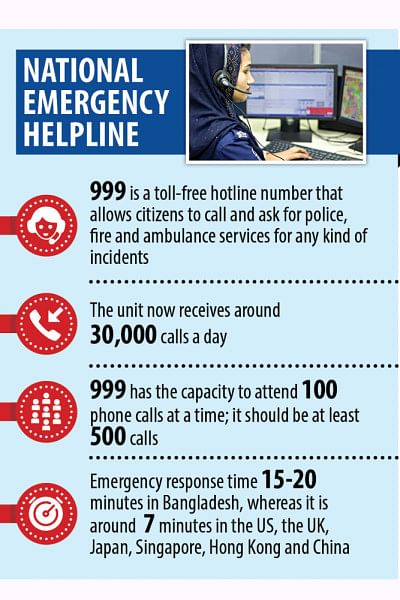Why is National Emergency Helpline 999 response slow?


The speed at which the National Emergency Helpline (999) responds to distress calls is much slower than that of developed countries due to an outdated operating system and manpower shortage.
The average response time of the 999 unit in Bangladesh is about 20 minutes against around seven minutes in countries like the US, the UK, and Japan, said several unit officials.
Because of such delayed response, the callers in distress run the risk of being deprived of emergency services, while many alleged that they had to wait for hours after calling the helpline.
999 is a toll-free hotline number that allows citizens in trouble to call and ask for help from police, fire service or ambulance service providers in case of any crimes, accident or other emergencies.
At present, the emergency helpline unit receives around 30,000 calls a day.
Officials at the unit said the response time would have come down significantly if their demand for providing the unit with automatic caller identification and location system had been met.
They said the Police Headquarters sent a demand note to the home ministry in this regard in May, 2018, and a decision to provide the unit with the system was made in August, 2019, after a series of meetings involving different ministries and government agencies.
"But it is yet to be implemented," one of the officials told this newspaper.
The system can locate the caller's exact address instantly which is not possible in the existing manual system, the official said.
Now, upon receiving a call, the staffers in the helpline unit ask about the assistance seekers' identity, location and the reasons for calls. They then arrange conference calls with the duty officers at police or fire stations or ambulance service providers whom the assistance seekers have to brief.
After that, the duty officer conveys the message to the police patrol team or fire service or ambulance closest to the caller's location to rush for help.
"The whole process is time-consuming and can be shortened significantly through automatic location identification system," the official said.
For instance, the official said, it took more than five hours to rescue 13 fishermen stranded at sea in December last year.
The engine of their boat broke down in the Bay of Bengal, leaving them stranded. After floating in the sea for five days, one of the fishermen managed to call 999 on December 5 noon from his cell phone that suddenly caught mobile network signal.
The caller, Md Jamal, could not give any location. He could only say that their boat engine went out of order after sailing for 18 hours to the east in the Bay of Bengal from Patharghata.
Following a frantic search up to 12 nautical miles in the Bay from Hatia, a Coast Guard team located the fishermen near Nijhum Dwip around 5:30pm, almost five hours after the call for help.
Officials in the helpline unit said the fishermen in distress could have been rescued much earlier if the automatic caller identification and location system had been in place.
Mohammad Tabarak Ullah, the chief of the unit, said the unit's response time is between 15 and 20 minutes compared to seven minutes in the US, the UK, Japan, Singapore, Hong Kong and China.
"The response time can be cut down drastically if the emergency helpline unit instantly gets the automatic caller's ID and location," he told The Daily Star.
Tabarak, an additional deputy inspector general of police, said they need a larger workforce to act swiftly as the number of emergency calls has increased.
The helpline unit started its operation on December 12, 2017, with 30 phone lines and 100 staffers. It got 8,000 to 12,000 calls per day in the first few months.
Currently, it has 392 personnel from police, the Department of Fire Service and Civil Defence and the Directorate General of Health Services to handle around 30,000 calls from all over the country every day.
It has the capacity to attend 100 calls at a time.
"If we are to respond quickly, we need to build the capacity to attend at least 500 calls at a time, taking into consideration the country's population of 17 crore," said an official involved in the emergency service.
The official further said the Police Headquarters that runs the helpline unit sent a proposal to the home ministry in January last year, saying the unit requires a workforce of 1,847 employees for smooth operation.
Besides, unit officials have sought Mobile Data Terminal (MDT) for all 1,800 patrol vehicles and Thana Dispatch System (TDS) for the 650 police stations across the country.
MDT is a tab-like device used in patrol vehicles to communicate with a central control system.
TDS is an electronic device through which the 999 unit can quickly dispatch to the police station concerned all the information it receives from the callers.
On a pilot basis, 320 police stations in the capital and several other cities have been equipped with TDS while 289 patrol vehicles have been provided with MDT.
Contacted recently, Home Minister Asaduzzaman Khan said the helpline would be provided with the automatic location identification system soon.
On the proposal for providing more manpower and logistic support, he said, "We are scrutinising it."

 For all latest news, follow The Daily Star's Google News channel.
For all latest news, follow The Daily Star's Google News channel. 






Comments